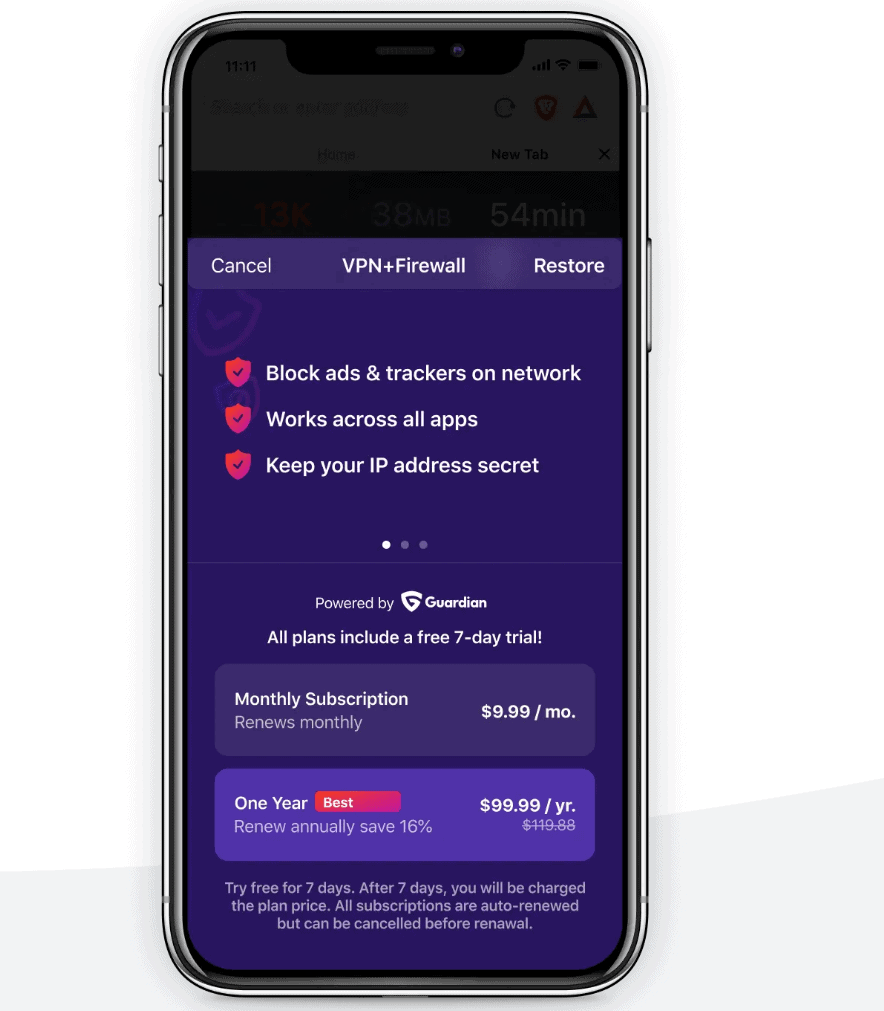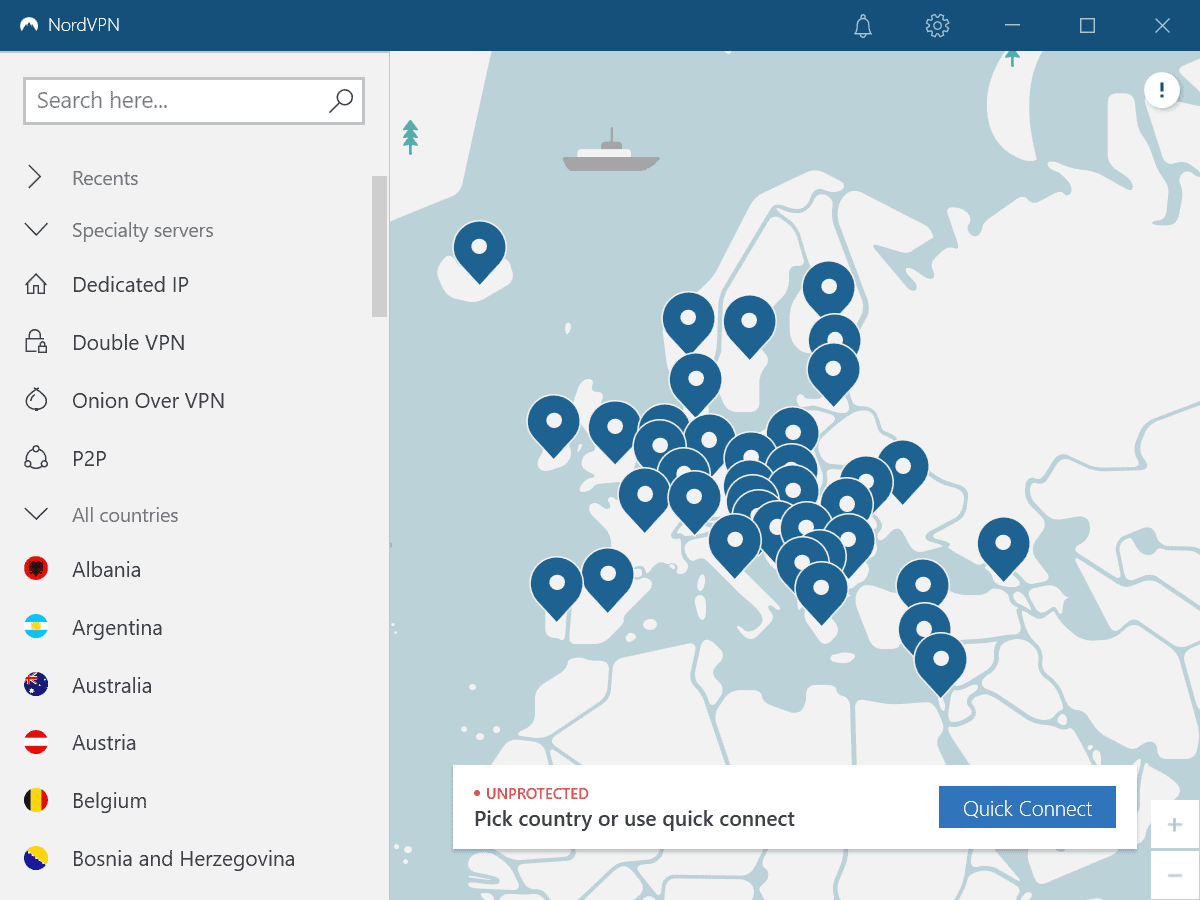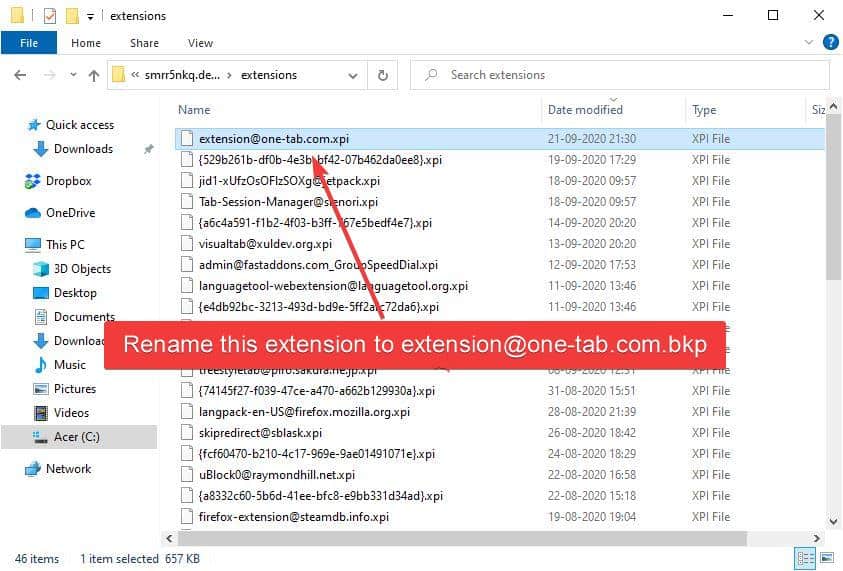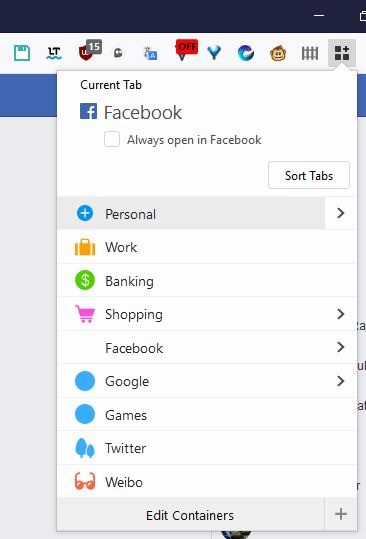Are paid extra services the next big thing for browser makers?

How do you monetize a web browser? That question used to have a simple answer: through search partnership deals. While some companies did not need any revenue coming from their browsers, e.g. Microsoft never really made money directly from Internet Explorer, others relied on search deals to finance development.
Nowadays, search deals are still valuable for browser makers but since the list of search provider that pay millions of Dollars for the right to be the default search engine in a browser is really small, it puts many browser makers in a precarious situation. The two main players when it comes to search are Google Search and Microsoft Bing; a few companies dominate regional markets, e.g. Baidu in China or Yandex in Russia, but their reach is limited to their markets and people that speak the language of the search engine.
Companies like Mozilla have to broker deals with companies that run competing products, and that is a problem. Microsoft developers the Microsoft Edge browser and Google the Google Chrome web browser.
Lately, browser makers who don't operate search engines of their own have started to test other forms of financing development. Some placed sponsored links on start pages, others have started to create new extra services and products.
Mozilla launched a VPN service recently for example that is available for $4.99 at the time of writing in select regions of the world. It is a standalone product, and while there is also a browser extension that acts as a proxy for the browser to protect its traffic, the main emphasize lies on the standalone version.

Brave Software, the maker of the Brave browser, announced the launch of a system-wide firewall and VPN for Apple iOS devices today. Powered by Guardian, an established application for iOS, it is also available as a add-on feature. Interested Brave users can purchase the app for $9.99 per month or $99.99 per year via in-app purchases and Brave Software plans to bring the technology to other platforms later this year.
The two examples have several things in common: first, that both companies leverage existing services to create these extra products, and second, that they both are useful to a subsection of users in better protecting their privacy and security while online.
Partnerships with established companies come in the form of revenue share agreements usually. Selecting a partner is beneficial as it allows the browser maker to leverage existing technologies and infrastructure. Downside to this is that some users may wonder why they should buy the browser maker's product and not the original product. One answer to that could be better integration or additional features, or even more comfort.
It is unlikely that the revenue that comes from these products will surpass the revenue gained from search deals, at least not in the near future. The main idea behind diversifying income streams is to reduce the dependency on a single company, and especially if it is a direct competitor.
Other browser makers will probably look very closely at how well these extra services perform, some may even have similar products in the pipeline.
Now You: What is your take on this development? What could happen if companies like Mozilla get independent of search money?






















Mozilla has mostly survived on Google revenue for keeping Google search on Firefox as default. I also get the conflict of that arrangement which is why Mozilla would like to rely less on it. But I wonder if this VPN service will do much more then create some small interest back with Firefox? I mean VPN’s are a dime a dozen and eventually we will see price competition. Not everyone even needs a VPN and at best maybe a free built in one in a browser would be enough.
I installed the just released portable version of Palemoon browser.
Upon running it for the first time it took me to start.palemoon.org but it switch to https://palemoon.start.me/users/home.
Of course no add-ons were installed yet. To my surprise googletagmanager was there data mining me!
What is going on with Palemoon???
For privacy, also see on the Pale Moon addons site –
Decentraleyes, PermissionsPlus, Pure URL and eMatrix (a fork of uMatrix).
@Pale Rider
The default homepage that Pale Moon uses for monetary reasons contains trackers. That being said, this is just a website, the browser itself does not contain any trackers. Go into Pale Moon‘s settings and change the default homepage to either about:blank or your preferred website.
Then, delete cache and cookies under History —> „Clear Recent History…“ Once that is done, install uBlock Origin from here, this add-on will protect you from tracking going forward:
https://github.com/gorhill/uBlock-for-firefox-legacy/releases/download/firefox-legacy-1.16.4.24/uBlock0_1.16.4.24.firefox-legacy.xpi
I also recommend the Self-Destructing Cookies add-on from the Pale Moon add-ons website.
Mozilla is preparing to layoff more workers, and is currently projected to lose over $90 million dollars this year. This is also the year they are renegotiating their contract with google. The few hundred million dollars they got from the oath lawsuit settlement won’t last long at this rate.
This is after they laid off over 70 workers and paid out hundreds of thousands of dollars in severance to them.
I don’t object as long as the commercial services aren’t pushed too agressively and FOSS doesn’t become crippleware or adware.
If the numerous frugal users are not willing to donate money, Mozilla etc. must find alternative sources of funds. For not all developers are hobbyists with a lot of time on their hands and happy with a tiny market niche. And competing with the likes of Google and Microsoft is neither easy nor cheap. However, I don’t know if offering paid extra services is the best way to raise (enough) money and compete effectively. I’ll leave that judgement to business economists and marketing experts.
@Gerard
Still under the impression that Mozilla funds itself via donations, huh? Donations are not even used for Firefox development:
https://old.reddit.com/r/firefox/comments/a98gmi/donations_to_mozilla_foundation_are_not_used_for/
Huh? Please read before you reply. Where did I write that Mozilla (still) uses donations for FFx development?
@Gerard
> If the numerous frugal users are not willing to donate money, Mozilla etc. must find alternative sources of funds.
Just wanted to make it clear that Mozilla never used donations for Firefox development. They fund themselves mainly via search engine royalties, and always have. 80%+ of Mozilla‘s funding comes directly from Google. User donations to the Mozilla Foundation (which is not the Mozilla Corporation that is actually in charge of Firefox development) go to various virtue signaling initiatives you‘ve likely never heard of.
“Are paid extra services the next big thing for browser makers?”
I guess you could call it a “big thing” for those struggling browser makers who need to sell extra services, but I doubt enough users will use such services to ever make it a “big thing”.
Chrome and Edge will likely always be free without such “extra services”, where most folks will likely keep using those.
“Microsoft never really made money directly from Internet Explorer”
That’s a moot point..
Google and Microsoft provide their browsers for free, as it’s a package deal for them, and indeed involves profit.
It’s hard to compete with that, even with the so-called privacy concerns that some users have.
And then there’s Safari.. Being that it only comes with Apple’s operating systems, then I consider it a paid browser, and thus the last of its kind.
I would pay for basic services if it meant no ads or data harvesting
I have news for you, you already can. Even with google products. gsuite has a different tos than the free google accounts and doesn’t track the data of its paid customers or send them ads.
@matthiew
Then buy into Apple.
All these companies can take their subscription services and shove it. Especially Adobe and Microsoft.
Brave is not a big company like Google or Microsoft. So they have to find a way to make money somehow. Mozilla on the other hand have screwed their Firefox users on both Windows and Android so many times that I don’t care any more what happens to that browser.
@Jeff “Mozilla on the other hand have screwed their Firefox users on both Windows..”
In what way exactly? It’s possible to configure FF to behave the way you want, right?
(I mean Firefox on Windows only- I don’t know how the Android version is)
@John Doe
Believe it or not, there are browsers which do not need extensive configuration to make them usable and privacy-respecting.
Implying privacy is the only thing that matters about a browser. I’ll stick with one that walks the talk about privacy out of the box without needing a million configuration changes, and which squarely puts the user in the driving seat the way Firefox once used to until version 4 – either use it with a minimal set of defaults as it is or customize the shit out of it the way you want to.
By breaking compatibility with dozens of XUL/XPI addons. And dropping customization and many features of the Firefox browser in innumerable ways. They tried to make it another Google Chrome.
This is not a good thing. Because as soon as browsers are all pushing these services, they will start constantly nagging you to use them. If I wanted to be nagged, I would run Windows.
The web browser is a solved problem. It does what it’s supposed to do, sans hardware accelerated video playback on Linux. But every new feature that gets added to web browsers is then twisted and misused by websites to annoy and mistreat visitors, for example, annoying dialog boxes that must be manually accepted before reading a page, Javascript which causes everything to come to a screaching halt and is so poorly engineered that they might as well just run a bitcoin miner on the visitor’s computer. And to visitors, don’t bother disabling your Javascript either. For one thing, Mozilla, Google, and Microsoft have all made it unnecessarily hard to do this in order to put the user in the passenger’s seat of his own computer, and for another, most sites are being explicitly designed to fail to work without Javascript now, in order to let publishers scan your system for ad blockers, use of private mode, and track every intricate movement of your mouse and keystroke. You can’t even read a text article without Javascript on most mainstream sites anymore, so that they can send all the aforementioned malware down the pipe!
Anyway, browsers only need maintenance and security fixes going forward, and that doesn’t cost much to do. So they don’t need to pollute my computer with even more advertising.
It isn’t a solved problem, because we live in a capitalist system. So you have to bring together the interests of users and browser makers.. Also since different corporations are in competition with each other, they have to fight for users.
The only current way to make money is via search, which gives google a lot of power. Unfortunately it will stay that way, except if the monetary incentives of the entire web change.
@Anonymous
>Unfortunately it will stay that way, except if the monetary incentives of the entire web change.
That’s very limited thinking. I can think of many reasons why a large company would provide a browser for 100% free without having to sell “extra services” and/or monetize users by tracking them; without having to change “the monetary incentives of the entire web”. For example, big companies dump a lot of money into PR, and that involves large donations to non-profits. As such, there’s room for change in that. Furthermore, both Google and Microsoft hold some powerful cards, and they can play them as need be at any time, by giving us what we want in regards to privacy.
That said, I agree that not much will likely change, but the pressure is growing for change, and the threat of antitrust laws and such are real.
Unless something drastic and very bad happens to millions of users, most users don’t care about browsers. Phones dominate the market with users spending most of their time on social media and texting. If social media continues to function satisfactorily, all is well.
The small amount of time spent browsing on a phone, which is a miserable experience swamped by ads on a tiny screen doesn’t matter much.
Reclaim some of the desktop? Maybe. Charge for a truly private version of FF, rename it and launch a huge campaign to sell it. There will be buyers but again, most desktop users can’t be bothered with privacy and are used to “free” software.
Many users actually enjoy interacting with notifications, ads masquerading as real humans, screaming at search assistants, etc.
Mozilla may be seriously overestimating the selectivity of general users. Seems Mozilla may be better off regaining the enthusiastic cult they once had and using that cohort to increase market share. They won’t do that with minor mods to FF or with this month’s alternate revenue attempt.
Hopefully not. I prefer that my browser pays me (Brave), not the opposite direction.
Somebody is paying Brave developers. Nobody works out of the goodness of their hearts…
@asd
Of course, I never said or implied anything else. But Brave is not asking for my money in exchange for random services so far. Instead, Brave Software gets a commission per ad displayed to the user (if the user opts into Brave‘s own privacy-respecting ads within the Brave Rewards system). They also receive a smaller amount of money from search engine royalties, but not enough to fund the project from that, i.e. they do not depend on this particular income.
Last but not least, there are also investors who believe in the success of the Basic Attention Token (BAT), the success or failure of Brave is closely related to the success or failure of BAT.
BAT is the worst possible name for any product right now… lol
Guardian on iOS is a joke. It doesn’t block anywhere near enough trackers. Well, maybe it does in the West, but it’s woeful for Asian sites. That and their pricing is typical Apple dev, meaning they’re stuck on that “less than a cup of coffee a month” mantra because the coffee in their posh Bay Area is already overpriced. I mean, can rent a VPS instance on Vultr or DigitalOcean and spin up a WireGuard VPN with better ad and tracking protection (Guardian FW on iOS only blocks trackers) with a local den resolver for around $5/mth, possibly less if I shop around (though cheaper options have tighter bandwidth restrictions).
Regarding the discussed topic; I personally would just prefer someone just make a capable browser that doesn’t track your movements and has a competent set of built-in privacy features without needing extensions; bare minimum for me would be uBlockOrigin level ad/script/frame blocking + canvas blocking + CSS Exfil protection + CDN redirecting + vim bindings + GTK/Plasma integration for Linux users (because Chromium based browsers are butt-fugly on Linux). Charge something like $30 (pay once, no subscription racket) and I’ll gladly buy it, and repeat purchase a new version every 3 years or so provided they keep up with whatever scummy practices the interweb throws at us. I suspect I’m in the minority though.
The easiest way for browser makes to make money with premium services is to make them so expensive that affluent customers subsidize those who just want to use a free browser. Like the 10$ VPN which is definitely overpriced.
Yeah, $10 per month for a phone VPN, which by regulated phone design is quite limited, is far too much.
Not for as long as a fair browser such as the free and open source, cross platform, Chromium exists. All other browsers could literally burn in Hell, the end-users will always have a good browser.
I also doubt projects such as PaleMoon or SeaMonkey would do these kind of shenanigans.
**Removed** [Editor: there is no need for that here]
Sorry, but I firmly believe Chromium (and, by that, Blink too) is the death sentence of a free, open Web. Google has it under its amoral, corrupted influence: this comes as no surprise. It’s not a case where “standardization” causes thriving developments, but technological stagnation and users being stripped away from what they previously owned. Besides, only its ungoogled fork is actually usable from a mindful user standpoint. No matter whatever malicious changes Google enforces are done, they can (at least, now) be reverted, however I cannot see a bright, open future for it should its dominance continue. Wish I could say Firefox was a proper alternative like it was for IE, but unfortunately I can’t as much as I believe it’s the least worst.
@Thaumiel
I think you fail to realize, like many here, how Chromium is actually developed. There are many contributors to the code, Google is just the most important one going by the number of commits, other contributors include Microsoft, Opera ASA, Intel, Samsung, Brave Software, Vivaldi Technologies, and a very large number of unaffiliated contributors. If Google “closed-sourced” Chromium, they would lose all outside contributions and would have to stem the project alone, which I don’t think they want to do really. Also, the last open source state of the code before Google “closed sourcing” it would still be publicly available, and someone big like Microsoft or even a collaborative effort of former non-Google contributors would pick it up and continue from there, this would eventually result in a Blink derivative slowly becoming its own, separate engine.
The point is – Google can’t do what they want with the code, and their influence is not as big as people commonly think it is. If they introduce a change that can no longer be circumvented and is negative, rest assured that a hard fork will appear, the resources for such a fork are available. But you may have noticed that Google has not done anything like that (yet), which is why the other Chromium-based browser still use their upstream (and contribute to it, of course).
I also do not believe that Mozilla surviving or not plays much of a role. For one, their market share is tiny even now, so if Google wanted to push something through, they could do it, no problem. Furthermore, Mozilla has a history of bowing to their Google sponsor and immediately following suit whenever Google proposes something at the W3C (Yes, even back in the day when Mozilla still had more market share). “Opposition” implies that you actually “oppose” something, it also implies that you are “independent”, which Mozilla is not, as far as Google is concerned. If you were informed about the discussions at the W3C, you would realize that Apple was the voice of reason far more often than Mozilla was, Mozilla usually sided with Google. So, what is the purpose of Firefox then?
Last but not least, to further illustrate my point: Imagine Windows never existed and various Linux distributions using the Linux kernel as a common core dominated the scene… Linux distributions = Chromium-based browsers, Linux kernel = Blink in this case – Firefox fans would be akin to a very small minority shouting that Linux dominance is evil despite everybody doing what they want with the Linux code anyway, claiming that FreeBSD was urgently needed to fix the situation.
I hope you see now how ridiculous this is, why should open source dominating the scene be a bad thing? It doesn’t matter if there is another open source project “competing” with the dominant one, because if there is something wrong with the dominant open source project, somebody (big) would take a closer look at it and fix the issue in their own variant.
PS: Ungoogled Chromium is okay, but I think Brave should be given some credit as well, at this point. Their adblock engine is one of the most progressive and they are currently undertaking the first serious anti-fingerprinting effort in a Chromium-based browser. UG has no feats comparable to that, but it’s a good browser still.
@Iron Heart
I understand your argument and appreciate your input, I may have appeared more disdainful than I intended in my initial reply. While I do agree with you (there isn’t much to disagree with, after all), I want to point out, explicitly, I am very dubious of Google being a trustworthy company. Android could be an interesting comparison: Chromium and the AOSP project should be relatively similiar in regards to supervision, am I correct? I could dare say Chrome is to Chromium what Android is equivalent to AOSP, featuring (or certainly having previously planned to, such as Manifest v3) either proprietary or locked down components, and very likely to be not friendly to users. Chrome has, like Android, has demonstrated a tendency to tighten on users freedoms. AOSP is unknown to most Android users, even worse than Chromium, and has no major player distributing its own “flavour” of it without malware. Android is the undiscussed only player in that duopoly market, shipped with pretty much all devices in a customized manner, with Google malicious components perfectly functioning, and, of course, Chrome.
I don’t think Chrome “pulling a SafetyNet” sort of thing (I can’t think of a proper analogy) is out of this world, with its dominance. Nowadays “Chrome” or “Google” is to most people Internet the same way IE was for most back in the day, isn’t it? Proper regulation I think is long overdue to ensure things remain well for the wounded, more consolidated than ever, Web. Well, that’s my strongly opinionated thoughts of it, at least. I really just do no want to endorse anything that has to do with Chromium, because I wish not to support the “one upstream source for everyone, hf threats if bad things get pulled in” concept and a Google led project that would have issues surviving on its own against a browser monopoly just like Gecko or EdgeHTML.
About Linux, I think your point isn’t exactly fit for this matter, as it has nothing to do with a company revolving all of its business around users, their juicy data, and advertisement.
Brave is indeed an interesting project, but I still feel slightly shady of them and their BAT practices. And yes, Mozilla is economically and.. technologically?.. serving under Google’s influence. I wonder if “paid extra services” would’ve, or may in the future, sever the link of affiliations, and consequently show more conflicting ideas. Most likely not, browsers are intricate beasts that require significant resources to develop and such sources would hardly suffice with the userbase of those who would most need it.. who knows, maybe something in the Internet is just conceptually wrong and this is a bad spot to be in.
What’s the problem with paid extra services? They gotta make money somehow.
Also, saying that Chromium is the only browser that matters is hilarious. Did you know that Google’s master plan is for the URL bar to disappear and eventually make it so most sites are only available through AMP. Once that’s done, the next step is for extensions to cease to exist, specially (ad)blockers and other anti-trackers, let that sink in.
Just keep complaining about Mozilla, that’s all you do anyway.
@good luck
When did you last check browser market share figures? Safari is the only non-Chromium browser with relevant market share these days.
As for your scare claims: The URL bar can‘t disappear because users will always require direct access to websites, suppose someone shares a link with you in written / printed form, how are you supposed to navigate there without a URL bar?
As for the „all through AMP“ stuff: This is equally unrealistic and stuff like this exists: https://chrome.google.com/webstore/detail/redirect-amp-to-html/kifkmmpiicbcnkjaliilaoeaojlldonl?hl=de
Extensions like that can also be distributed even if the Chrome Web Store should shut down, which I highly doubt, since extensions make or break the browser. Google also distributes various extensions themselves. Your claim is akin to saying apps will cease to exist on Android, it just won‘t happen.
The answer to a potential demise of adblocking extensions are native non-extension adblockers like the ones included in Brave or Bromite, these already exist.
As for Mozilla, if Google should really plan to do all the things you claim they plan, I am 100% sure Mozilla would follow suit, partly because 80% of their funding comes directly from Google, partly because their browser doesn‘t have enough market share anymore to stop anything at this point (not saying Mozilla stopped anything even when they had more market share back in the day, in their case it‘s really only hypothetical, since they fully depend on Google).
@Iron Heart
Never mentioned market share, all I’m saying is that other engines/browsers matter because that way Google can’t do whatever the hell they want.
As for the URL bar, you better believe that it’s on the chopping board, just wait.
As for AMP and (ad)blockers, extension support can be terminated by Google whenever they want.
Mozilla can find other partners for revenue, don’t worry about that, there’s infinite business opportunities around the Web.
@good luck
I hear these rumors (if you have no source, it amounts to a mere rumor) about the demise of the URL bar, but those that spread them never address how one can access a specific URL without the URL bar, in case the URL is not clickable (e.f. on a sheet of paper). Care to elaborate how that is supposed to work without a URL bar? It‘s not so much a matter of belief, it‘s more or less a matter of the URL bar being irreplaceable so far.
Also, if Google should really do that, which is impossible on a technical level IMHO, there would still be forks like Vivaldi which run their own interface on top of the Chromium interface, and there can be no doubt that Chromium would continue to work with URLs internally, making them visible in a different UI is not a problem at all. But then again, I don‘t think there is any substance to such rumors.
Google can‘t terminate extension support unless the management is Windows Phone-level stupid, because that would be like begging Opera, Brave, Vivaldi, and most importantly MS Edge, to take over Google‘s market share. People actually use these extensions, you see, and the open source Chromium (which Chrome is based on) supports extensions currently, the other Chromium-based browsers (especially MS Edge) would have zero problem patching the related code back in, and people would likely switch to them. The former Chrome extensions would start to appear in Edge‘s and Opera‘s extension galleries. Google isn‘t that stupid, especially when MS could profit heavily from such a move.
Mozilla‘s search revenue is bound to diminish along with Firefox‘s market share, Firefox will be below 4% market share by the end of the year. That means Mozilla will no longer earn half a billion $$$, but a figure much lower than that. If Google loses interest, the next best candidate would likely be Bing, but then Mozilla would be dependent on Microsoft (don‘t know if you consider that progress). Yahoo won‘t partner with them again after Mozilla terminated their last contract early in order to switch back to Google. But market share is not only important for revenue, it‘s also a consideration for web developers testing their websites against certain browsers. When I test a website against Chromium and Safari, I‘ll have 96% of all users covered, how likely do you think is continued Firefox support if its market share continues to decline? That‘s one of the reasons why Mozilla has started importing more and more V8 code (Chrome‘s JavaScript engine) into SpiderMonkey (Firefox‘s JavaScript engine) – they want to make it as easy as possible for web developers to support Firefox, by becoming more like Chrome in terms of rendering – this is of course a result of their lack of importance. But then, at this stage, why use FF?